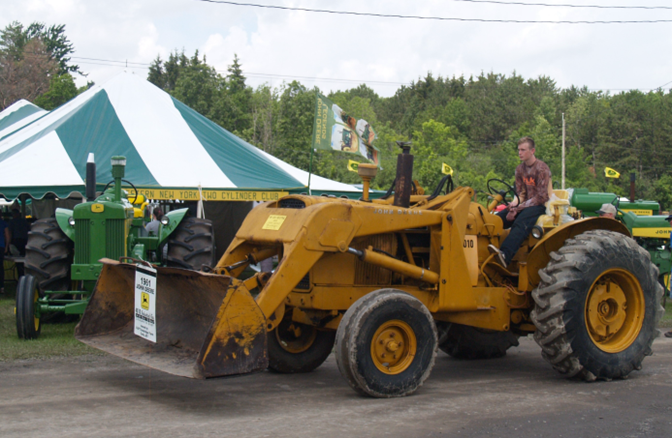New York State Two Cylinder Expo
New York State John Deere Expo Association
Expo XVI
Feature Tractors
JOHN DEERE NEW GENERATION TRACTORS
The John Deere New Generation tractors, introduced in 1960, marked a significant milestone in the history of agricultural machinery. The development of the New Generation tractors was a culmination of John Deere’s commitment to innovation and customer-centric design, resulting in a product line that reshaped the agricultural landscape.
The origins of the New Generation tractors can be traced back to as early as 1953 when John Deere recognized the need for more powerful and adaptable farm equipment to meet the evolving demands of modern agriculture. In response to this, the company embarked on a comprehensive research and development initiative, aiming to create a new generation of tractors that would exceed the capabilities of their predecessors. Key to this initiative would be John Deere’s commitment to innovation and a customer focused design.
The result of this endeavor was the introduction of the John Deere New Generation tractors in 1960. These innovative machines revolutionized farming practices and set new standards for power, efficiency, and versatility. These tractors represented a paradigm shift in agricultural machinery, incorporating cutting-edge technologies and design principles to deliver unmatched performance and reliability. To achieve this result required an all-new design, i.e., not just new engines, but virtually all the major systems. This included the transmission, the hydraulic system, and the electrical system. The sleek, modern appearance of the New Generation tractors and vastly improved operator platforms were the result of the work of the famed industrial design firm of Henry Dreyfus. The New Generation tractors were indeed an entirely new tractor!
The John Deere New Generation tractor models introduced in 1960 included the 1010, 2010, 3010, 4010, and 8010. (Approximately one hundred 8010s were produced. Most were ultimately reworked and re-badged as 8020s) Variants included: row crop, high crop, orchard, industrial, utility and crawler. Engines were available in gas, diesel, and LPG. The 1010 and 2010 were built in Dubuque, IA, all the others were built in Waterloo, IA. The introduction of these models represented a comprehensive overhaul of John Deere’s tractor lineup, reflecting the company’s commitment to meeting the evolving needs of farmers and revolutionizing farming practices.
4010 Industrial, 1 of only 10 built with a gas engine
Owned by Paul Trowbridge of Corfu, New York
One of the most significant innovations of the New Generation tractors was the introduction of the Syncro-Range transmission. The John Deere 3010 and 4010 tractors were equipped with the innovative Syncro-Range transmission, which allowed for on-the-go shifting between select gears. This transmission system offered eight forward and two reverse speeds, allowing for a wide range of operating capabilities to suit various farming tasks.
The Syncro-Range transmission in the John Deere 3010 and 4010 tractors also contributed to improved productivity. The ability to shift gears without clutching or stopping minimized the effort required to operate the tractor, resulting in a more comfortable and convenient experience for the operator, especially during long hours in the field. This feature was particularly beneficial when performing tasks that required frequent speed adjustments, such as tillage, harvesting or road transport. Overall, the Syncro-Range transmission in the John Deere 3010 and 4010 tractors represented a significant technological leap, providing operators with enhanced control, efficiency, and comfort, and contributing to the overall success and popularity of these iconic tractors.
The John Deere New Generation tractors also featured improved hydraulic systems. The closed center hydraulic system was revolutionary at the time. The closed center design allowed it to operate very economically, requiring less than two engine horsepower. The hydraulic system could deliver 20 gallons per minute (gpm) of flow at 2000 pounds per square inch (psi) of pressure. By comparison, competitive tractors typically provided only 10 to 15 gpm at 800 to 1000 psi. This superior performance enabled the New Gen tractors to power a wide range of new implements and attachments. These advantages contributed to a significant increase in productivity, allowing farmers to accomplish tasks more effectively and with less effort.
In conclusion, the introduction of the John Deere New Generation tractors in 1960 marked a pivotal moment in the history of agricultural machinery. These groundbreaking machines not only redefined the capabilities of farm equipment but also set a new standard for performance, efficiency, and operator comfort. These tractors became synonymous with quality and innovation, earning the trust and loyalty of farmers around the world. The legacy of the New Generation tractors continues to shape the agricultural landscape, embodying John Deere’s dedication to innovation and customer satisfaction.
